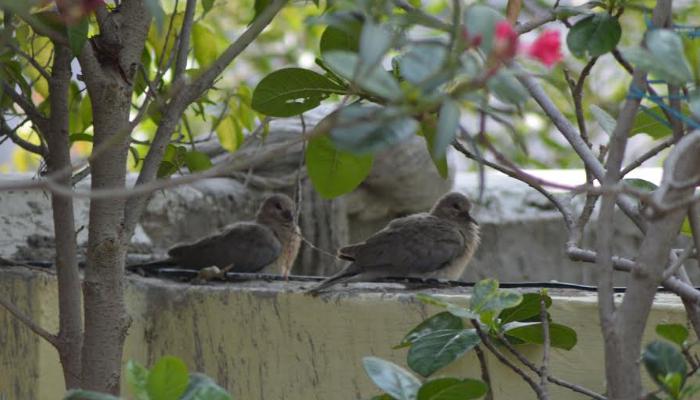Iron Grip, Nature's Gift
Spending time in quarantine after recovering from Covid19, one morning we spotted some hectic activities at our rooftop garden where two petite chicks were hopping from one pot to another. They would take small flights and sit inside the pot for hours till their mom arrived, fed them by regurgitation –feeding in an unusual way of interlocking her beak with those of chicks as if sparring like wrestlers . The mom actually first swallows the grains and then takes out to feed the chicks . The dove chicks are known for leaving the nest 12-13 days after hatching. However, they do not take long flights. They fledge at 15-17 days of age. My family has spent over a fortnight protecting Tony-Mony –yes we named them -from the local predator birds and cats and also making available feed for them. But on the very first day when we noticed the pair of small birds , a powerful storm approached at dusk. As the clouds thunder and lightning forced the people to stay indoors, the two chicks were all alone . Their mom and dad were missing. We saw them taking a small flight as they disappeared in the Neem tree. While its branches were blowing precariously, we spotted them perched over a stem that also continued to be swayed by the strong winds. Soon it started raining cats and dogs. It was pitch -dark. As I went to sleep, there was another spell of squall. The lightning in the night and the thunder that followed sounded even more ominous. We waited for the storm to be over and prayed for their safety At the crack of the dawn, we rushed out and looked for the fragile birds at the Neem tree.
Also read: Cry to Save Panna from Ken Betwa Project Gets Louder
As we learnt more about the birds from the Handbook of the Birds of the World , we found them to have special tendons called flexor digitorum longus and flexor halluciss longus which are connected to flexor muscles in the leg. The digitorum branches control the first three toes in front while the halluciss works the back toe, known as the hallux. This enables the bird to have a locked tight grip to ensure it does not become a part of the flying branches. When birds land on a tree, their toes automatically tighten around the branches on which they are perched. When the leg is bent, the tendons and then the muscles stretch tight and pull the toes around the branch. “This holds them in place during high winds or when they sleep. Birds must make an effort to unclench their toes in order to take off. They may sway with the branch and wobble in high winds, but they won’t let go of the branch”, we learnt.
Life Lessons from the
Petite Bird
The Lazy Mom
This dove has a pinkish head and is monogamous, solitary and territorial. The pair-bonds are for life. The nest is a flimsy platform built by the female, made with roots, twigs and stems often brought by the male. The same nest can be used several times, and some doves use old abandoned nests of other birds’ species. The female lays two glossy white eggs. The incubation lasts about two weeks mainly by the female, but the male may replace her sometimes. And the chicks come out only to be abandoned by the lazy mom. After they grow to the age of 14 days, they are never taken back to the nest , not even during the night storms . The chicks are left out and they learn life lessons to survive.
By: Deshdeep Saxena





Comments
Post a Comment